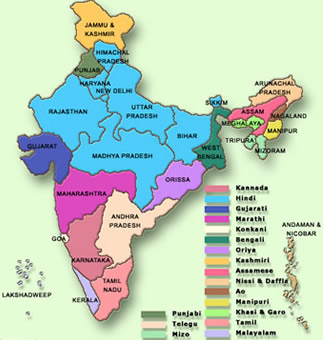Learn Hindi Through Malayalam Pdf Free Download

Hindi
Namaskār – Welcome
Hindi, also known as Khadi Boli, Khari Boli, belongs to the Indo-Aryan branch of the Indo-European language family. It is spoken as a first language primarily in northern and central Republic of india by more 258 meg people (Ethnologue). Information technology is the language that unifies multilingual Bharat, habitation to some 400 different languages/dialects. Outside of India, Hindi is spoken in Commonwealth of australia, Bangladesh, Belize, Bhutan, Botswana, Canada, Djibouti, Republic of equatorial guinea, Germany, Guyana, Kenya, Nepal, New Zealand, Philippines, Singapore, Sint Maarten, South Africa, United Arab Emirates, U.k., United states of america, Yemen, Republic of zambia (Ethnologue). Such a wide distribution makes Hindi one of the well-nigh spoken languages of the world.
Hindi vs. Urdū
 The name Hindi is of Persian origin. The Persians used information technology to refer to the Indian people and to the languages they spoke. Scholars postulate that Hindi developed in the eighth-10th centuries from khari boli, the speech around Dehli which was adopted by the Moslem invaders to communicate with the local population. Somewhen, it developed into a diversity called Urdū (from Turkish ordu 'camp'), characterized past numerous borrowings from Western farsi and Standard arabic, which became a literary linguistic communication. In the concurrently, the linguistic communication of the indigenous population remained relatively free of borrowings from Western farsi and Arabic, and instead borrowed words and literary conventions from Sanskrit. This linguistic communication became Hindi.
The name Hindi is of Persian origin. The Persians used information technology to refer to the Indian people and to the languages they spoke. Scholars postulate that Hindi developed in the eighth-10th centuries from khari boli, the speech around Dehli which was adopted by the Moslem invaders to communicate with the local population. Somewhen, it developed into a diversity called Urdū (from Turkish ordu 'camp'), characterized past numerous borrowings from Western farsi and Standard arabic, which became a literary linguistic communication. In the concurrently, the linguistic communication of the indigenous population remained relatively free of borrowings from Western farsi and Arabic, and instead borrowed words and literary conventions from Sanskrit. This linguistic communication became Hindi.
As a result of these different influences, Hindi is written in the Devanagari script and draws much of its vocabulary from Sanskrit, while Urdū is written in the Perso-Arabic script and draws a great deal of its lexicon from Persian and Arabic. The two languages too differ in a number of relatively small means in their sound system and grammar. Both Hindi and Urdū take been used every bit literary languages starting in the 12th century. Under the influence of English language, Hindi and Urdū literature flourished starting in the 18th century.
Hindi and Urdū have a common colloquial form, called Hindustani. Hindustani never achieved the status of a literary linguistic communication, although Mahatma Gandhi used it as a symbol of national unity during India's struggle for independence from England.
Status
Hindi is the primary official language of the Wedlock government of India. It is the master tongue of nigh a tertiary of India'due south 1.09 billion people. Hindi became the official language of India in 1965, although the Constitution of India as well recognizes English plus 21 other official languages.
After the Independence of India from Britain in 1947, the Authorities of India undertook the standardization of the language. In 1958, 'A Bones Grammer of Modernistic Hindi' was published as a upshot of the piece of work of a government-appointed committee. Hindi spelling was standardized, and a standardized system of transcribing the Devanagari alphabet was devised.
Hindi and English
For speakers of Bharat'due south approximately 400 languages/dialects to function inside a unmarried country requires some common linguistic communication. The choice of this language, known in India as the 'link' language, has been a sensitive political upshot since independence in 1947. Efforts to reach a consensus on a unmarried national linguistic communication that is adequate to all the diverse language communities have been largely unsuccessful.
Both Hindi and English are extensively used, and each has its own supporters. On the one hand, native speakers of Hindi, concentrated in northern and central India, assert that English is a relic from Bharat's colonial past. In addition, since it is spoken mostly by the country's educated elite, it is also exclusive to be India's official language. Proponents of English, on the other manus, contend that the use of Hindi is unfair because information technology disadvantages those who have to learn it as a second linguistic communication.
Education in English continues to be a prerequisite for social status. English remains the sole language of higher education in almost every field of learning. Lawmaking-switching between Hindi and English language is extremely common, especially amidst educated Indians.
Click on the MLA Interactive Language Map to find out where Hindi is spoken in the U.South.
Dialects
There are many regional varieties of spoken Hindi. Literary Hindi has four varieties: High Hindi, Nagari Hindi, Literary Hindi, and standard Hindi.
Construction
Audio arrangement
The sound organization of Hindi is fairly typical of Indo-Aryan languages.
Vowels
Hindi has 11 oral vowel phonemes, i.e., sounds that differentiate word meaning. Vowels tin be oral or nasal. Nasalization makes a divergence in word meaning, e.g., ak 'a institute', ãk 'draw'.
| Front | Central | Back | |
|---|---|---|---|
| Shut | i | u | |
| About-close | ʊ | ||
| Mid | due east | ə | |
| Open-Mid | ε | ɔ | |
| Well-nigh-open up | æ | ||
| Open up |
- /i/ = ea in peat
- /I/ = i in pit
- /e/ = e in pet
- /ε/ = i in girl
- /æ/ = a in pat
- /ə/ = a in ago
- /u/ = oo in too
- /ʊ/ = oo in proficient
- // = oo in bog
- /α/ = a in auto
Consonants
Hindi/Urdu have a large consonant inventory. The use of consonant clusters is extremely express, even in borrowed words. They occur by and large in initial and medial position. Just a restricted gear up of consonant clusters can occur at the terminate of words. Consonants can be geminated (doubled) in medial position.
The exact number of consonants is difficult to determine due to regional differences in pronunciation. In improver, the extent to which consonant sounds that announced only in borrowed words should be considered part of Standard Hindi is also a thing of contend. In the table below, consonants that exercise not occur in all varieties of Hindi, and those that occur primarily in borrowings are given in parentheses.
| Bilabial | Labio-dental | Alveodental | Retroflex | Mail- | Velar | Uvular | Glottal | ||
|---|---|---|---|---|---|---|---|---|---|
| Stops | unaspirated voiceless | t | ʈ | (q) | |||||
| aspirated voiceless | pʰ | tʰ | ʈʰ | kʰ | |||||
| unaspirated voiced | ɖ | ||||||||
| aspirated voiced | bʰ | dʰ | ɖʰ | gʰ | |||||
| Fricatives | voiceless | (f) | .s | ʃ | (ten) | ||||
| voiced | (z) | (ʒ) | (ɣ) | ||||||
| Affricates | unaspirated voiceless | ts | tʃ | ||||||
| tʃʰ | |||||||||
| unaspirated voiced | dʒ | ||||||||
| aspirated voiced | dʒʰ | ||||||||
| Nasals | …… | ..ɳ | ŋ | ||||||
| Laterals | ….. | ..ɭ | |||||||
| Flap or trill | unaspirated | ɽ | |||||||
| aspirated | ɽʰ | ||||||||
| Approximant | ʋ |
- In that location is a contrast between brusk and long consonants, eastward.g., pəta 'address' and pətta 'leaf'.
- There is a contrast betwixt aspirated vs. unaspirated stops and affricates, including voiced ones, e.g., p—pʰ, t—tʰ, 1000—kʰ, b—bʰ, d—dʰ, g—gʰ, /ʈ/—/ʈʰ/, etc. Aspirated consonants are produced with a stiff puff of air.
- There is a contrast between and upmost vs. retroflex consonants, e.chiliad., /t/ – /ʈ/, /d/ – /ɖ/, /north/ – /ɳ/. Apical consonants are produced with the tip of the natural language touching the roof of the mouth, whereas retroflex consonants are produced with the tongue curled, so that its underside comes in contact with the roof of the rima oris.
- /ʋ/ is often realized as /5/.
- /ʃ/ = sh in shop
- /tʃ/ = ch in chop
- /dʒ/ = j in job
- /j/ = y in yet
Stress
Stress in Hindi/Urdu unremarkably falls on the penultimate (i.east., next to the terminal) syllable of a word. The position of stress lone does not touch on word meaning.
Grammer
Hindi is a highly inflected language which utilizes prefixes and suffixes to form words and to limited grammatical relations. Hindi uses postpositions, rather than prepositions to express various instance relationships. Postpositions crave that the nouns be used in the oblique case.
Nouns
Hindi nouns are marked for the following categories:
- number: singular and plural;
- gender: masculine and feminine;
- instance: directly (nominative), oblique, and vocative;
- the directly case is used to marker subjects of sentences; the oblique example is used with postpositions
- there are four declensional paradigms for masculine and four declensional paradigms for feminine nouns;
- adjectives concur with the nouns they modify in number, gender, and case;
- adjectives have fewer example forms than nouns;
- pronouns have more than case forms than nouns;
- 3rd-person pronouns are the same as proximate and remote demonstratives yəh 'this and vəh 'that.'
- there is a second-person honorific pronoun ap which is used with both singular/plural and male/female person addressees.
Verbs
Hindi verbs are characterized past the following:
- Hindi verbs occur in the post-obit forms: root (kha 'consume'), imperfect stem (khatA), perfect stem (khayA), and infinitive (khanA). The stems agree with nouns in gender and number.;
- person: 1st, 2nd, 2d honorific, 3rd;
- number: atypical and plural;
- tense: present, past, future;
- tense distinction of present vs. by is expressed past the auxiliary verb honA 'to be.'
- aspect: imperfective, and perfective;
- mood: indicative, imperative, optative.
Politeness
Second-person personal pronouns are marked for 3 levels of politeness. Verbs in the 2d person are also marked for politeness.
- singular form tu (informal, extremely intimate, or disrespectful)
- singular form stomach (informal and showing intimacy)
- plural class ap (formal and respectful).
Discussion guild
Hindi word gild is typically Subject-Object-Verb. Modifiers precede the nouns they alter.
Vocabulary
Due to the influence of Hinduism, Hindi derives almost of its high-level vocabulary from Sanskrit. As a effect of the Moslem influence in Northern Republic of india, Hindi also has many Western farsi, Arabic and Turkish loanwords. Due to the influence of Islam, Urdu vocabulary has a greater per centum of loanwords from Persian and Standard arabic than does the vocabulary of Hindi.
Here are a few mutual Hindi phrases in transcription and in Devanāgarī.
| Hullo/adieu | Namastē. नमस्ते |
| Thank you lot (formal) | Dhan'yavāda. धन्यवाद |
| Delight. | Kr̥payā. कृपया |
| Yes | Hāṁ. हां |
| No | Nahīṁ.नहीं |
| Man | Ādamī. आदमी |
| Adult female | Mahilā. महिला |
Below are Hindi numerals 0-10 in transcription.
| 0 | 1 | ii | 3 | 4 | 5 | half dozen | seven | eight | 9 | x |
|---|---|---|---|---|---|---|---|---|---|---|
| shunya | ek | do | trīn | car | pānc | che | sāt | ath | nau | das |
Writing
Hindi is written in the Devanāgarī script, a descendant of the Brāhmī script. Devanāgarī script is too used for writing Sanskrit, Marathi, and Nepali. There is a fairly adept correspondence betwixt the characters and the sounds they correspond. The Devanāgarī script is a syllable-based writing system in which is each syllable consists of a consonant plus an inherent vowel /ə/. There are a number of rules governing the realization of inherent vowels. Vowels accept different representations in writing depending on whether they are independent or following a consonant. Devanāgarī is written from left to right. Sentences are separated past vertical lines.
Have a look at Commodity 1 of the Universal Declaration of Human Rights in Devanāgarī and in romanization.
| – सभी मनुष्यों को गर्व और अधिकारों के मामले में जन्मजात स्वतन्त्रता और समानता प्राप्त है। उन्हे बुद्धि और अन्तरआत्मा की देन है और परस्पर उन्हें भाईचारे के भाव से बर्ताव करना चाहिये । |
| All homo beings are born gratuitous and equal in dignity and rights. They are endowed with reason and conscience and should act towards ane another in a spirit of alliance. |
Did Y'all Know?
Hindi words in English
English has borrowed a number of words from Hindi. Among them are these familiar ones:
| English discussion | from Hindi |
|---|---|
| bandana | bandhnu , a method of dyeing |
| bangle | bangri 'colored glass bracelet or anklet' |
| chetah | chita 'leopard' |
| chutney | chatni |
| coolie | quli 'hired servant' |
| cot | khat 'couch, hammock' |
| dinghy | dingi 'pocket-size boat' |
| dungaree | dungri 'coarse cloth' |
| guru | guru 'instructor, priest' |
| jungle | jangal 'forest, uncultivated state' |
| loot | lut 'stolen holding' |
| pajamas | pajama 'loose garment' |
| pundit | payndit 'learned man, teacher' |
| swami | swami 'master' |
| thug | fname of Hindu sect Thugee whose members killed people for sacrifice to the goddess Kali |
Difficulty
Linguistic communication Difficulty
 How difficult is it to larn Hindi?
How difficult is it to larn Hindi?
Hindi is considered to be a Category II language in terms of difficulty for speakers of English.
DOWNLOAD HERE
Posted by: corbettsudielits.blogspot.com